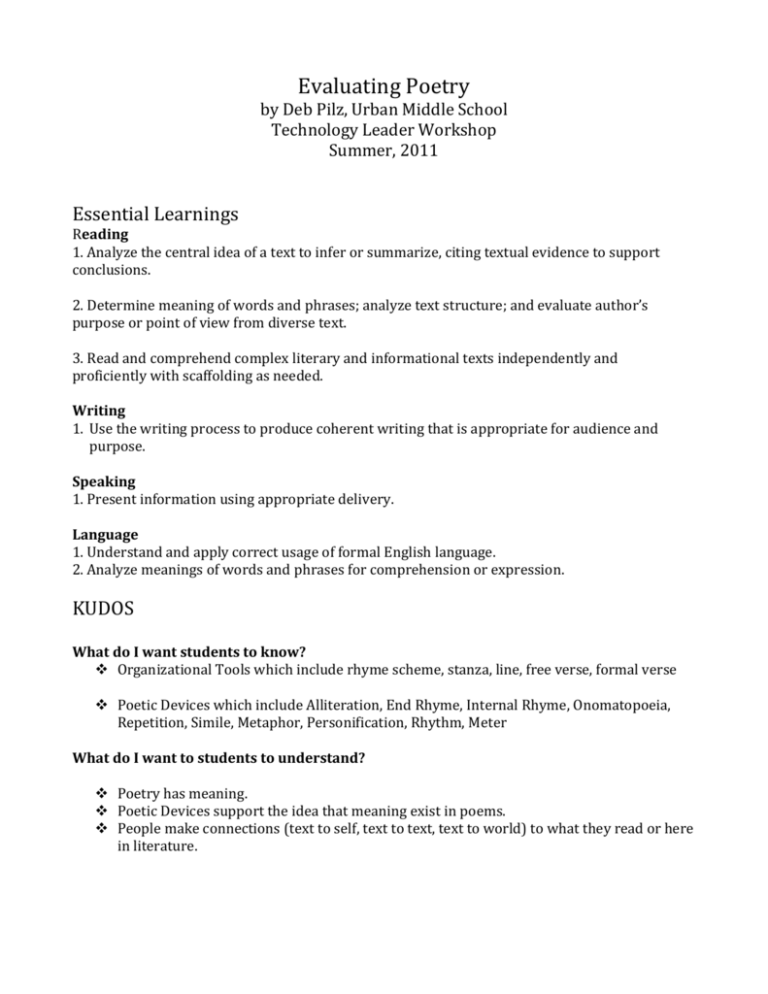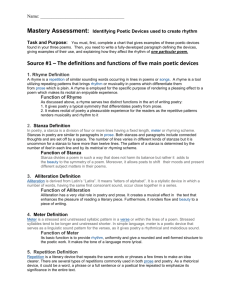Evaluating Poetry
advertisement

Evaluating Poetry by Deb Pilz, Urban Middle School Technology Leader Workshop Summer, 2011 Essential Learnings Reading 1. Analyze the central idea of a text to infer or summarize, citing textual evidence to support conclusions. 2. Determine meaning of words and phrases; analyze text structure; and evaluate author’s purpose or point of view from diverse text. 3. Read and comprehend complex literary and informational texts independently and proficiently with scaffolding as needed. Writing 1. Use the writing process to produce coherent writing that is appropriate for audience and purpose. Speaking 1. Present information using appropriate delivery. Language 1. Understand and apply correct usage of formal English language. 2. Analyze meanings of words and phrases for comprehension or expression. KUDOS What do I want students to know? Organizational Tools which include rhyme scheme, stanza, line, free verse, formal verse Poetic Devices which include Alliteration, End Rhyme, Internal Rhyme, Onomatopoeia, Repetition, Simile, Metaphor, Personification, Rhythm, Meter What do I want to students to understand? Poetry has meaning. Poetic Devices support the idea that meaning exist in poems. People make connections (text to self, text to text, text to world) to what they read or here in literature. What do I want students to do? Day 1 – Organizational Tools of Poetry Introduce Poetry by talking about how poems are lines and stanza where as essays and narratives are sentences and paragraphs. Go over organizational tools in poetry. Students will be in eight groups of three with large pieces of roll paper with Rhyme Scheme, Stanza, Free Verse and Formal Verse written on two of the eight sheets of paper. Students will read handouts on the organizational tool and web what they learned. After ten minutes groups will rotate. Groups will share. Rhyme Scheme: A rhyme scheme is a regular pattern of rhyme, one that is consistent throughout the extent of the poem. Poems that rhyme without any regular pattern can be called rhyming poems, but only those poems with an unvarying pattern to their rhymes can be said to have a rhyme scheme. Rhyme schemes are labeled according to their rhyme sounds. Every rhyme sound is given its own letter of the alphabet to distinguish it from the other rhyme sounds that may appear in the poem. Stanza: Poems are written in stanzas such as Couplet, Triplet, Quatrain, Sestet, Septet, and Octave. There are lines in stanzas not sentences. Free Verse: Free verse is poetry that does not use rhyme or structure to create its poetic effects, but relies solely on its words to create its emotional and aesthetic effect. Free verse does not recognize boundaries and is a much more experimental mode of poetry than formal verse. Meter In most poems, the lines are written according to patterns of rhythm. Poetic meter is the measure of a line of poetry. It is rhythm that can be measured in poems. The smallest of these metrical units is the ‘syllable’. English syllables are two kinds: accented or stressed, and unaccented or unstressed. An “accented syllable” requires more wind and push behind it than an unaccented; it also maybe pitched slightly higher or held for a slightly longer time. After the syllable, the next largest metrical unit is the ‘foot’, which is group of two or more syllables. Formal Verse: Formal verse, as the name implies, follows a form of some kind; in other words, it has a pattern. This pattern can be based on rhyme, meter, structure, alliteration, or any other aspect of poetry you’d care to name. Day 2 – Poetic Devices Show the YouTube video entitled Poetic Devices in Song Groups of two to three students will web search definitions and examples of poetic devices using the iPads. These will be the required devices: Alliteration, End Rhyme, Internal Rhyme, Onomatopoeia, Repetition, Simile, Metaphor, Personification, and Meter. Each group will need to find two additional devices. Their information will be recorded on large pieces of paper with the device with a definition on one side and two examples on the other side. One of the two examples needs to be original. Use quizlet.com to make flash cards. These flash cards could be accessed on the iPads for student practice if Flashcardlet is down loaded. Day 3 Day 4 Day 5 Day 6 Day 7 – Poetic Devices Video Show the Teacher Made iMovie of a Sample of illustrated Poetic Devices Students will work in groups of three to create and present a video of at least nine devices using flip cameras and iMovie. Day 8 – Evaluate Poems Model using the poem, “Alone” by Maya Angelou the meaning of the poem, the poetic devices found in the poem and a connection to the poem. With partners evaluate the poem “What If” by Shel Silverstein and post on http://www.wallwisher.com/wall/poemmeaning the meaning of this poem. With partners evaluate the poem “What If” by Shel Silverstein and post on http://www.wallwisher.com/wall/poeticdevice a poetic device found in the poem. With partners evaluate the poem “What If” by Shel Silverstein and post on http://www.wallwisher.com/wall/poemconnection a connection to this poem. Day 9 – Evaluate Poems Find two poems in the Literature Book and evaluate the meaning of the poem, the poetic devices found in the poem and make a connection to the poem. Day 10 – Present Poem Present one of the two poems. Read the poem and share the evaluation. Explain the meaning of the poem, the poetic devices found in the poem and a connection to the poem.









